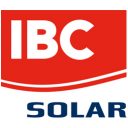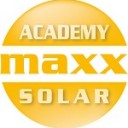Solar system maintenance and cleaning.
Does the dirt visibly collect on the frame edges of your solar modules or do your modules no longer “shine”? Do you have yield losses or no increasing yields in recent years? Then solar system maintenance and cleaning of your photovoltaic system is probably due.
Here below one can see the difference between a solar panel that has been cleaned, and one that has not yet been cleaned:
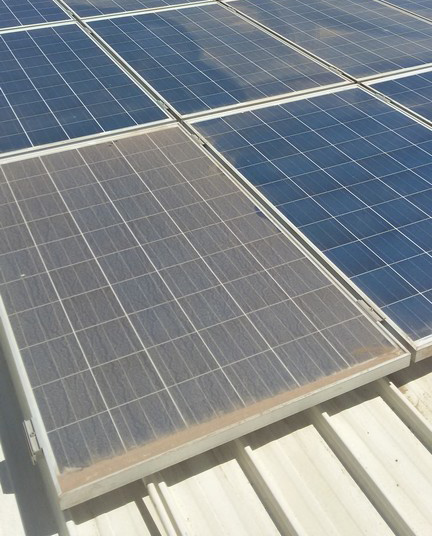
Solar system energy production and monitoring
It is normal for solar system to lose energy production as they age at a rate of about 1% per year. But if the energy production of your solar system is significant lower than expected, it might be time to clean the panels. It is therefore also necessary to regularly monitor the energy production of your solar system. All good solar systems comes with a user-friendly online monitoring portal for your system.
Here is an example of an energy monitoring system showing monthly energy production, compared by year. In this example the total monthly energy production is compared side by side for each year. There was various factors affecting this system.

Why solar panel cleaning is required
Over time, you will find that your photovoltaic modules are covered with a fine film of environmental dirt. The amount of dirt depends on the roof pitch and the type of modules used. Although most dirt is cleaned automatically by rain, this fine film is not removed. This makes it necessary to manually clean the panels, as this film of dirt can cause a yield loss of up to 15% per year. Another problem arises at the frame edges, where the dirt collects. Normal tap water, and a broom can be used for the cleaning of your solar modules. To see what the energy yield of your solar system should be, you can use this calculator.
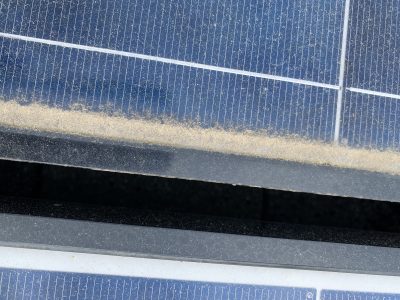

What factors affect solar panel soiling?
Panels get especially dirty in winter months where there is not a lot of rain to clean the panels, and there is more dust in the air than in the summer. Solar panels installed at a low incline, of say ten degrees or less, also get much dirtier than panels installed at a larger incline.
Loss of revenue
Currently in January 2021, in South Africa, Pretoria, electricity costs R 2.80 per kilowatt hour! At the current exchange rate that is 16 Euro cents, or 19 USD cents. Say your 10 kWp (kilo Watt peak) solar system can produce 1 200 kWh (kilo watt hours) of energy per month in the summer. That is the average amount of energy produced by a 10 kWp system in Pretoria. Then a 15% reduction of energy would be: 180 kWh. Multiply that by the cost of electricity, that means each month you would be losing out on a saving of: R 504.00! (34 USD / 28 Euro) So definitely worth it to spend money and or time to get the panels cleaned.
Residential solar system cleaning
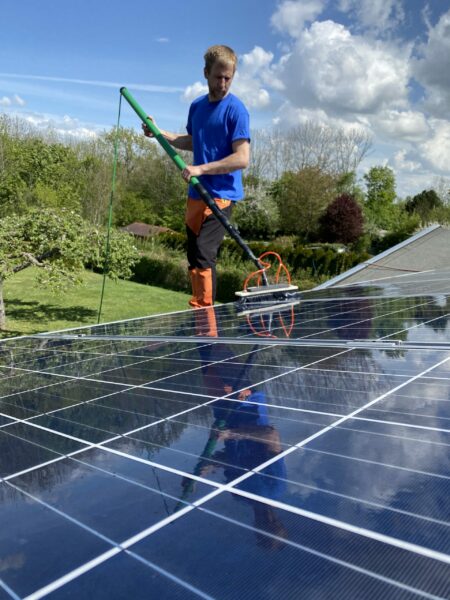
Most residential solar system are easily reachable and easily cleaned by the home owner. However, one might need to get a specialist in to clean panels that are difficult to reach. One needs to determine if it is worth the cost based on the size of system, electricity tariffs, and potential loss of revenue. As a guideline, if you compare the production per month of the last month to the production of previous years, and there is more than 20% difference, then it is probably time to clean your panels.
Commercial solar system cleaning
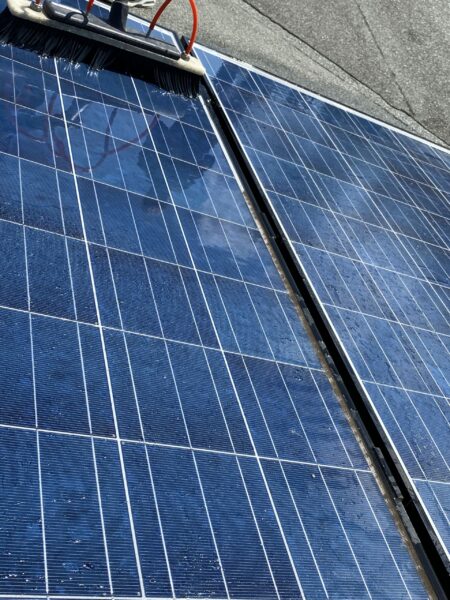
For large commercial solar systems, soiling can have a big impact on revenue loss. For these systems it is most definitely worth getting a professional cleaning company in to clean the panels.
17.02.2021 |
Tesla brings a solar photovoltaic inverter on the market.
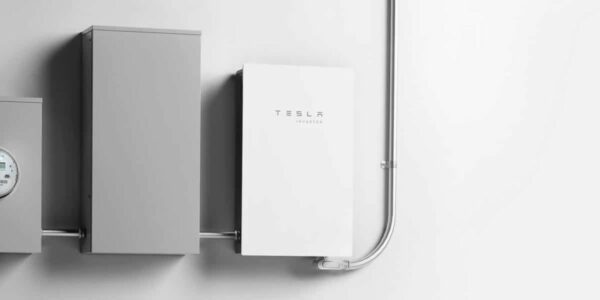
The Californian-based electric car manufacturer finally put its expertise in power electronics to good use in the photovoltaic industry and brought its own solar inverter on the market.
Tesla is becoming a market leader by offering a complete ecosystem of renewable energy components. In the past years, a lot of inverter manufacturers added car charges to their portfolio, but the inverter was always their main focus. Tesla did the reverse, and started off by offering batteries and car charges, then solar systems and now finally solar inverter.
The Tesla solar inverter is available in two versions a 3.8 and a 7.6 kW version. The 3.8 kW version has two MPPTs (maximum power point trackers), and the 7.6 kW version has four MPPTs. Most other inverters smaller than 10 kW only has two MPPTs. Tesla says its inverter has an efficiency of 97.5%. it is not stated whether this is the weighted efficiency of the California Energy Commission (CEC) or the maximum efficiency.
As required in the USA the inverter has an integrated quick shutdown function and offers protection against arcing and earth faults. Tesla also says that the product was designed to seamlessly integrate with the Tesla power wall battery and the Tesla app. That the Tesla app enables monitoring of power generation and consumption.
Tesla has published selected data from its inverter on its website, but not a complete datasheet. It is therefore not entirely clear what the app will be able to do in terms of system integration and optimization.
As a rule of thumb, the more devices come from a single manufacturer, the easier it is for the software to coordinate them and improve system efficiency - a trend that was already observed last year.
The company could also use its experience and production capacities from the manufacture of electric cars to achieve price and quality advantages.
Drive trains in electric vehicles require DC / DC and DC / AC conversion stages, as batteries generate direct current and motors can more efficiently be operated with alternating current. It remains to be seen whether this know-how can be transferred to photovoltaic products for domestic use and whether it would improve functionality, efficiency or robustness. The 12.5-year warranty offered when the Tesla inverter was announced would suggest the latter.
26.01.2021 |
Top Innovation Champion 2020 - maxx made it!
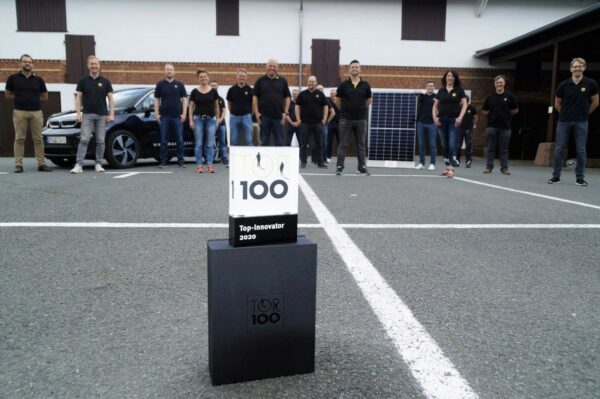
Letting go of the old and daring to try the new: innovative medium-sized companies like us are not afraid of change, but see it as an opportunity. This is what convinced us in the 27th round of the TOP 100 innovation competition.
About „TOP 100“
Since June 19, 2020, we have officially been among the TOP 100! In the scientific selection process, we particularly impressed in the categories "Innovation-promoting top management" and "Innovation climate".
We are mega proud of this award! This also shows once again how innovation-promoting photovoltaics and the industry in general is.
TOP 100 companies, like us focus on sustainable and intelligent energy concepts. We are the specialist in Thuringia for solar power and offer our customers turnkey solutions for photovoltaic systems and storage solutions.
The special thing about it: Thanks to the intelligent priority energy control, each customer can decide for himself how his energy should be used. For example, if the electricity stored in the battery for the night use, should be self-consumed, exported or if the electric car should be charged first.
To ensure that we can offer every customer the right solution, we also focus on training our employees. Everyone who starts with us undergoes a comprehensive seminar and training program, including product training.
About „TOP 100“ - the competition
The TOP 100 companies were subjected to around 120 test criteria. They explained, for example, how they organize innovation processes within the company, how they design the working environment for employees so that they can be creative, and what innovation strategies they pursue (explanation of the test criteria at: https://www.top100-germany.com/test-criteria.html). To ensure that all companies have the same opportunities, the award is awarded in three size categories: up to 50 employees, 51 to 200 employees and more than 200 employees.
As a mentor of the competition, science journalist, Ranga Yogeshwar was impressed by the TOP 100 companies.
"The innovative strength of these medium-sized companies forms a counterpoint to shareholder value orientation and the platform economy, which often exploits its service providers and is primarily interested in customer data […]. The innovations of the TOP 100, on the other hand, are an expression of a "we" culture […]“, he said.
"The SMEs are concerned with securing the future in the long term. They don't think about progress from the perspective of short-term profit; instead, they focus on securing the company's existence," says Yogeshwar.
About „TOP 100“ - key figures
Innovations make a significant contribution to healthy development, as some of the TOP 100's key figures show:
- The sales growth of the award-winning companies is 22.7 percentage points above the industry average.
- The top innovators generate 36.8 percent of their sales with market innovations or innovative improvements that they have introduced in the previous three years.
- From 2016 to 2018, all 257 TOP 100 companies applied for a total of 4,584 patents.
About „TOP 100“ - the history
Since 1993, Compamedia has been awarding the TOP 100 seal for special innovative strength and above-average innovation success to medium-sized companies. Scientific management has been in the hands of Prof. Dr. Nikolaus Franke since 2002. Franke is the founder and director of the Institute for Entrepreneurship and Innovation at the Vienna University of Economics and Business. With 25 research awards and over 200 publications, he is one of the leading innovation researchers internationally.
The mentor of TOP 100 is science journalist Ranga Yogeshwar.
Project partners are the Fraunhofer Society for the Promotion of Applied Research and the BVMW association of small and medium-sized enterprises. As media partners, manager magazine, impulse and W&V accompany the company comparison.
More info at www.top100-germany.com
12.01.2021 |
Interview with Dieter Ortmann – CEO of maxx-solar & energy in Germany
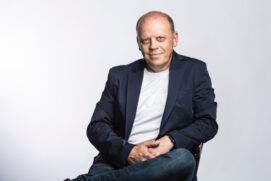
Dieter Ortmann, CEO of maxx-solar & energy in Waltershausen, Germany.
He founded the company in 2008 and has been very successful ever since. In the new year 2021, let's interview the maxx CEO and tap into his knowledge.
True to maxx-solar's solgan: Let's talk about it:
How was 2020 for you?
Incredibly "moving." Never in the history of photovoltaics in Germany has there ever been so much "movement" in the industry. The topic of climate change is pushing everything what is related to renewable energy in a very positive direction - even despite Corona.
What did Corona do to maxx-solar?
Nevertheless, Corona there was a break in the take-up of solar after all. Not in relation to the "movement" towards renewable energy, but rather in the funding structures that existed. Due to the general Corona Aid, all forces were withdrawn from PV promotion and no permits were issued for 6 months. Any power outage in South Africa is more helpful than a government support program, which can be turned on and off.
What do you see as the biggest challenge for 2021?
There is significantly more PV being built in Europe and around the world. We're taking the highest backlog we've ever had into 2021. PV is by far the cheapest form of energy worldwide, even in cold Germany. Our biggest challenge is getting enough skilled workers to keep up. A real issue that will also affect South Africa is the availability and price of solar panels. China has passed a huge new solar program, Europe is moving ahead, and Joe Biden wants to re-join the Paris Climate Agreement immediately after taking office and he wants to accelerate the advancement of renewable energy (RE) in the US. There will be a huge demand for modules and inverters!
Will Corona play a role for maxx in Germany?
Hopefully less in the future. The stimulus programs are pro renewable energy, people's willingness to invest in PV is high. If the vaccinations shows positive effects and the infection numbers go down, it will be more of an economic accelerator.
What are you most looking forward to in 2021?
Full order books and possible trips to South Africa. Furthermore, we are progressing with the maxx-online-academy. And if everything goes as planned, we will be able to offer the first online trainings on a completely new level in the first half of the year! Stay curious! ;-)
What was the biggest innovation/coolest invention in PV for you in 2020?
A new cell developed in Germany with extremely high efficiency and the rapid development in battery cells.
What do you think will be the biggest innovations / coolest inventions / improvements in PV in 2021?
The speed will increase, especially in battery development! However, it is quite important that solar companies, craftsmen and planners continue to develop at the same pace. From my own experience, this is where the highest potential lies, especially in digitalization!
Maxx- solar & energie was elected TOP Innovation Champion in 2020. Innovation and digitalization are increasingly on everyone's lips today. How are digitalization and the solar industry related?
They are connected very, very closely! With battery storage and, above all, the e-car, it is no longer possible without digitalization. Everything has to do with everything and it is becoming very complex! Learning is the key for a good further development of solar companies.
What skills do young people need in today's job market in the PV industry and especially in the future- what is your assessment and observation?
On the one hand, it needs the really good craftsmen who are able to "think along". On the other hand, electrotechnical and digital knowledge that goes far beyond "basic knowledge" will become elementary. You also need people in the company who are familiar with the electricity market and its models. With e-mobility and flexible electricity tariffs, the topic of smart homes is becoming increasingly present. A well-known journalist wrote in 2020 that there will soon be only 2 "classes" of employees in Germany - the unaffordable and the superfluous.... the topic of AI will accelerate this forecast extremely. Education and the drive to educate oneself is the key.
Future viability of the industry: your assessment - is it worth pursuing a career here?
Absolutely! International economists predict that the transformation of the energy system and the grids will require more skilled workers than are currently employed in the automotive industry. Getting involved and choosing RE is clearly a very good decision!
What do you think about mentoring and when should people look for a mentor?
Always! Mentors have accompanied me my entire working life and I have enjoyed the exchange. It doesn't have to be an external mentor. It can be the partner, the boss, the colleague. Mentoring only works with openness and curiosity!
If you had to gather a mentoring team of three people around you (you can chose who ever you want! anything is possible), which three would you choose?
My first boss, a Benedictine monk and an extremely successful master craftsman who knows about processes, organization and structures.
What is maxx-solar planning in Germany for 2021? Surprise? Major projects?
No, rather less. We are struggling to process all orders orderly. We will build more than ever before, which will push us to our limits. Improve the topic of digitalization of processes and bring it to a really high level, and train new people. If everything works out, we'll build one of the biggest rooftop plants in Thuringia!
Something you'd like to share with us?
South Africa has the advantage of looking at how PV is developing elsewhere. Many mistakes can be avoided by observing others closely. We will also share these learning curves in the maxx academy. Invest in training and digitalization in good time. Stay cautious and healthy!
06.01.2021 |
Merry Christmas !
We all know that this year was one of a kind and tested us in many ways: patience, hope, resilience, being able to adapt and sometimes to say: It is like it is.
We from maxx-solar & energy were one of the lucky ones that could go on with our business and proceed on our way to be part of the energy transition.
As you can see we also didn´t stop to work on exploring and finding new ways to share our knowledge and keep in touch with you.
For 2021, we plan to start the maxx-solar & energy blog here on this website.
We will upload content – once per week, starting on the 6th of January 2021 – with an Interview of CEO of maxx-solar&energy in Germany: Dieter Ortmann.
After that, we will cover the following topics and hope to create content and information that is helpful to you and your business, development and personal carrier. Topics we will cover are:
- Solar technology (latest developments and trends from around the world)
- Solar energy carriers (mentoring, networks, experts)
- maxx-solar Germany news (whats going on in Germany?)
- Digitalisation and education (how is the PV-industry related to that?)
So stay tuned and let´s talk about it in 2021

Your maxx-blog-team!
20.12.2020 |
Load shedding solutions
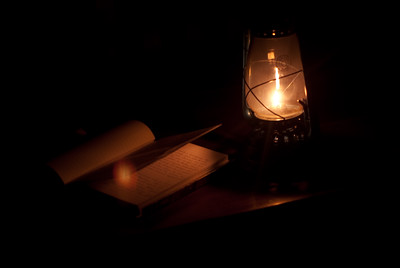
With more people working from home in their home offices, load shedding has become a real problem. Especially extended periods where even the batteries of phones and laptops go flat.
To stay productive in your home office, even during load shedding, one needs backup power. Generators are a good solution for short periods of time that do not happen too often. But if load shedding becomes a daily occurrence and happens for extended periods, generators become problematic. They make a lot of noise, and air pollution, that not you nor your neighbours will be too happy about. They become expensive in maintenance and fuel cost, and it also becomes a hassle to change over to generator power and start the generator.
A better alternative is to use UPS / Backup power systems. A UPS, backup system makes use of inverter/chargers and batteries. This has several advantages over generators:
- It is completely silent
- It is completely automatic
- It is uninterrupted: Computers, TVs and internet do not go off at all
- It is completely maintenance-free
- It uses no fuel
- Causes no pollution
With the UPS based load shedding solution, the following list of appliances can be backed up.
- LED lights
- TV
- Fridges
- Wi-Fi
- Computers
- Chargers for laptops and cellphones
Additional benefits UPS-based load shedding solutions
Additional benefits of UPS, Inverter and battery-based backup solutions are the following.
Protect sensitive electric and electronic equipment
Power going on and of frequently can cause damage to sensitive electric and electronic equipment. Several fridges, freezers, laptops, TV and computers were damaged during the last load shedding period in South Africa.
Adding solar power
An inverter/charger and battery-based system is basically half of what one needs for a complete off-grid solar system. It is very easy to just add a few solar panels to the system. This will then charge the batteries with solar power instead of grid power.
This has two advantages, firstly it saves you money as electricity from the solar panels is free. Secondly, it will extend the period of backup power, as one is no longer limited to the amount of energy stored in the batteries, but can also add all the energy produced by the solar panels to extend the available time of backup power. If there is enough solar power for energy being used, the equipment can even be permanently off-grid.
Our partners, IBC Solar offers further information on available load shedding solutions. Click here to visit their website.
Need some help in finding your load shedding solution?
We have a database of competent installers and solar consulting companies in Southern Africa. A good installer/consultant will be able to help you determine your backup power requirements.
Simply fill on the following page to request a consultation/quote from competent, pre-approved companies in your area.
15.07.2020 | Schlagwörter: Load shedding solutions
How does a grid-tied solar system work?
A grid-tied solar system is also referred to as a:
- Grid-tied photovoltaic system;
- Grid-tied PV system;
- Grid-connected solar system;
- Grid-connected photovoltaic system; or
- Grid-connected PV system
Grid-tied systems are connected to, and dependent on, a utility grid to function. Electricity is generated from solar panels.
Grid-tied system components
Grid-tied systems consist of three main components:
- solar panels;
- one or more inverters; and
- an energy meter.
Batteries are not connected to a grid-tied system.
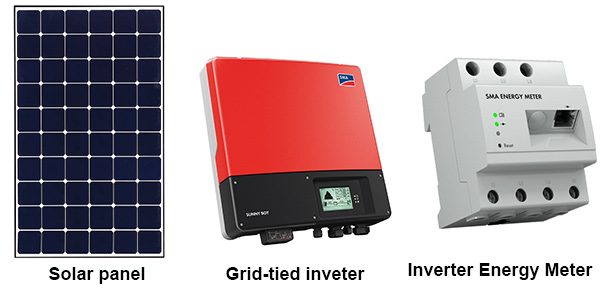
How it works
Rooftop solar panels convert sunlight into DC (direct current) electricity. The solar panels are connected to a grid-tied inverter, which converts the DC electricity into AC (alternating current) electricity. The inverter is then connected to the main DB (distribution board).
AC electricity has a specific frequency (normally around 50 Hz Herz). The inverter synchronises with this grid frequency. Electricity produced by the solar panels supplements electricity supplied by the grid.
Grid-tied solar system diagram
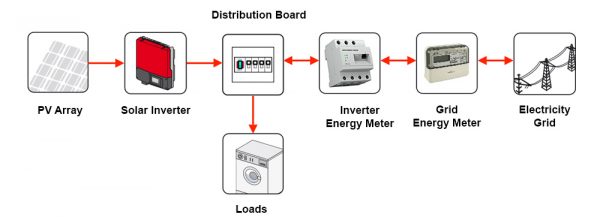
Energy Flow
Normally, electricity only flows from the grid to the building. But when a grid-tied solar system is installed, electricity can also flow back to the grid i.e. electricity can flow in both directions (as shown by the arrows in the diagram above).
The electricity produced by the solar panels will always follow the shortest route. This means electricity is first used within the building. If the solar system produces more electricity than the building requires, the excess is exported to the grid. From there it is used by your closest neighbour.
On the other hand, if the building is using more electricity than the solar system is producing, the grid supplies the shortfall.
Measuring the energy produced, used and exported
The inverter and energy meter measure all electricity produced, used, imported and exported. This data is uploaded to an internet server which can be accessed later, either on a website or via an app on your phone.
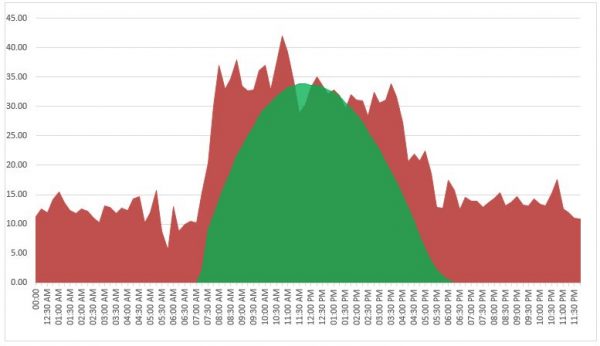
Advantages of grid-tied solar systems
- Cost-effective system: there are no expensive batteries.
- Quick return on investment: the typical payback period for a system is 4 to 6 years.
- High reliability: as there are fewer components and system requirements compared to hybrid or off-grid systems.
- Little to no maintenance required.
Disadvantages of grid-tied solar systems
- No backup power: there are no batteries and the system is dependent on the grid to work. When there is a grid power failure, the system also shuts down.
- Dependent on a stable grid: if the grid frequency or voltage is outside an acceptable range, the system shuts down.
- Energy production does not match energy usage: solar energy is produced in a typical solar production bell curve, mainly between 9 am and 4 pm. If the energy is not used immediately it is exported. Typically, the tariff earned for exported electricity is lower than the tariff paid for imported / self-consumed electricity.
Illustrative example
Using actual figures will explain this better. If the typical daily consumption of a building is 30 kWh and the solar system can produce 30 kWh during daylight, then a substantial amount of the electricity generated flows back into the grid. During the day, the meter turns backwards and builds up “credits”. At night, electricity is drawn from the grid and the meter turns forward again, using the “credits”. If the balance right, the meter will show zero usage over 24 hours!
If consumption increases to 40 kWh in 24 hours, the solar system still supplies 30 kWh for free. The remaining 10 kWh are purchased from the grid. If the building only consumes 20 kWh, the solar system “exports” 10 kWh. The solar system is now a power producer and the electricity can theoretically be sold to the grid.
For more information on how to correctly size a grid-tied solar system click here.
Need some help in sizing your solar system?
We have a database of competent installers and solar consulting companies in Southern Africa. A good installer/consultant will be able to help you determine your energy requirements.
Simply fill on the following page to request a consultation/quote from competent, pre-approved companies in your area.
14.02.2020 |
We’re excited to share that the Tesla Powerwall two will be available to order in South Africa in 2020.
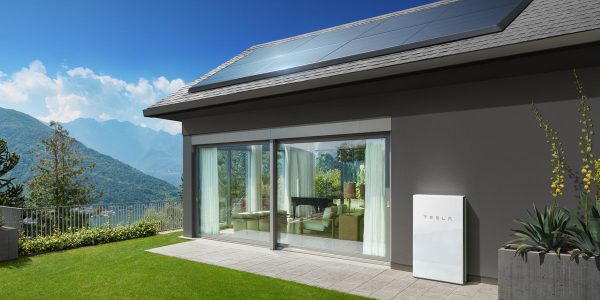
The Tesla Powerwall two stores surplus energy produced by your solar system during the day to power your home with sustainable energy at night. Backup power even protects your home during grid outages—keeping your lights, appliances and Wi-Fi running.
Interested in finding out more about the Powerwall two? Then please click here to register your interest. A Tesla Powerwall Certified Installer will contact you to discuss your needs.
06.01.2020 |
Press release: 12 November 2019
Solar energy Made in Germany - The KYA-Energy Group was supplied with an off-grid 30 kWp solar system in Lomé, Togo.
Official inauguration 15 November 2019, Lomé
The electrification and provision of reliable and clean energy is one of the key development drivers in West Africa. The Togolese government aims to electrify all households by 2030 by means of grid expansion, the use of small off-grid solar systems and solar mini-grids.
A few mini-grids have already been installed for rural communities, with another 317 to follow. This tremendous task can only be accomplished by training local engineers and installers to install, operate and maintain solar mini-grids.
The German solar company maxx solar & energy GmbH & Co. KG, GREEN Solar Academy and the KYA-Energy Group have joined forces to advance with their combined expertise, the use of mini-networks in the country.
As part of the dena RES project, Togo, a 30 kWp Made in Germany pilot plant was installed at the headquarters of the KYA-Energy Group in Lomé. The system not only supplies power to the headquarters of the KYA-Energy Group, but is also used to train solar installers within the GREEN Solar Academy.
Representatives of the Federal Republic of Germany and the Togolese Ministry of Energy will inaugurate the solar system and officially open the GREEN Solar Academy on 15 November 2019.
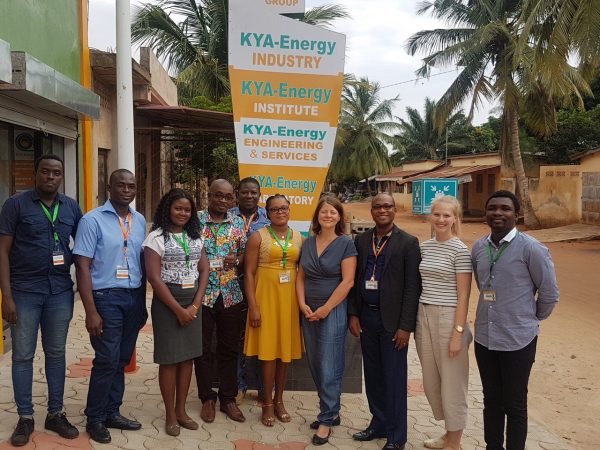
Electrification and the provision of reliable and clean energy are important development factors in West Africa. Access to electricity is the basis for better education and economic development. Solar energy plays an important role in this development process due to its many uses, affordability and independence from fossil fuels.
The sun does not send a bill, making it the ideal resource for the electrification of Africa. Mini-grids have become a standard solution for rural electrification. Nevertheless, the use of solar technology is still new and project implementation, operation and maintenance of the equipment can pose challenges.
KYA-Energy Group
Prof. Dr. med. Yao Azoumah and his team have been in the solar business in Togo, since 2015. His company KYA-Energy Group provides complete solutions for photovoltaics, and also operates a research and training department. Their main business areas are, the installation and sales of solar systems for residential and commercial customers. The company’s strength lies in the design and sales of off-grid systems for small to medium sized organizations.
The right partner
During a seminar trip to Germany in 2017, Prof. dr. Yao Azoumah met maxx | solar & energy GmbH & Co. KG. and found the right partner to expand their business in two ways: the wholesale of solar systems made in Germany, and a training academy for the West African market. "One year ago, Prof. Azoumah and I met for the first time and developed the idea to install a pilot PV system, Made in Germany, in Lomé. "Thanks to the support of the German Energy Agency GmbH (dena), we will be able to commission a 30 kWp solar system as an additional system at KYA-Energy this week, "says Dieter Ortmann, Managing Director of maxx | solar & energie GmbH & Co. KG.
Maxx-solar in Africa
Dieter Ortmann started his work in Africa in 2011. He built maxx | solar energy PTY Ltd. as a training and wholesale company for Southern Africa. "With Prof. dr. Yao Azoumah, we have found the right partner for expanding our business to West Africa and want to use this off-grid pilot project to demonstrate the quality, functionality and sustainability of German solar technology." said Dieter Ortmann.
About the system
The 30 kWp grid-independent solar system is the second solar system for the headquarters of the KYA-Energy Group in Lomé. "Our business is growing and we have recently built new workshops. The possibility of adding a 30 kWp solar system to our current 10 kWp solar system in cooperation with a German partner gives us the opportunity to generate the required electricity ourselves and to demonstrate various technologies on our site, "says Prof. Dr. med. Yao Azoumah.
The 30 kWp off-grid system combines German solar technology with an innovative monitoring concept from the KYA-Energy Group. 105 solar modules of the German company IBC with an output of 285 Wp was installed. The system will produce around 90 kWh of energy per day.
The electricity is consumed mainly during the day and stored in part in 48 BAE batteries with a total capacity of 1750 Ah at 48 V for use at night and in low sunlight conditions. In order to maximize the energy yield and to synchronize the energy production with the energy consumption, the modules are aligned in different directions.
With the German battery manufacturer BAE Batterien GmbH from Berlin, maxx and KYA have not only found a supplier, but also a partner. Jan IJspeert, Managing Director of BAE Batterien GmbH, supports the pilot project as he sees West Africa as an important market for his high-quality batteries. "We want to support KYA and the Togolese government in the sustainable development of a reliable energy supply," said Jan IJspeert.
GREEN Solar Academy
The 30 kWp off-grid system will be at the heart of the GREEN Solar Academy's training focused on solar mini grids. The GREEN Solar Academy is the successor to the maxx | solar academy. Together with 10 local partners, GREEN currently offers independent training in 11 academies in 9 countries in Africa. GREEN stands for the Global Renewable Energy & Efficiency Network, because the aim of the Academy is not only to provide training, but also to build a network of PV installers across Africa. Since 2011, more than 2000 solar installers have been trained and become part of the network.
GREEN and KYA have joined forces to bring the Academy to West Africa and provide GREEN Academy training in the region. The first KYA-operated GREEN Solar Academy is the Academy in Togo. The KYA team successfully participated in several GREEN Solar Academy training programs and this month will offer the first solar installation training program.
Official inauguration
One year after finding our ideas, we welcome the representative of the Federal Republic of Germany and the Minister of Energy to the official inauguration of the 30 kWp off-grid solar system and the start of the GREEN Solar Academy Togo on 15 November 2019.



Supporting organizations
The Dena-RES-Project Togo is being launched by the German Energy Agency and the German Ministry for Industry and Energy and implemented with funding from the "Exportinitiative Energie" of the dena-Renewable-Energy-Solutions-Program.

Deutsche Energie-Agentur (dena)
Dena is the competence centre for energy efficiency, renewable energies and intelligent energy systems. As an agency for "applied energy transition", we contribute to achieving the energy and climate policy goals by developing and putting into practice solutions, both nationally and internationally. For that, bring together partners from politics and business across all industry sectors. The shareholders of dena are the Federal Republic of Germany and the KfW Bank group. https://www.dena.de
Exportinitiative Energie
With the "Exportinitiative Energie" Initiative, the "Bundesministerium für Wirtschaft und Energie (BMWi)" (Federal Ministry for Economic Affairs and Energy) supports small and medium-sized German companies in the energy sector in the development of foreign markets. Addressed are companies that offer energy solutions in the field of renewable energy, energy efficiency, smart grids or storage.
The aim of the "Exportinitiative Energie" initiative is to position and disseminate German energy technologies more internationally, in order to increase the market potential for German technologies and German know-how.
In line with the respective export phases, the export initiative focuses on information transfer, business development and networking.
www.german-energy-solutions.de
dena-Renewable-Energy-Solutions-Programm (dena-RES-Programm)
With its dena-RES-program, the German Energy Agency (dena) supports companies in the renewable energy sector in opening up markets. In attractive target markets, energy technology will be installed at representative institutions in publicity and advertising, and comprehensively supported by PR, marketing and training activities.
These flagship projects funded by the Federal Ministry for Economic Affairs and Energy (Bundesministerium für Wirtschaft und Energie, BMWi) " as part of the "Export Initiative Energy" aims to demonstrate the quality of German products in the field of renewable energies and to facilitate the sustainable entry into new markets for participating companies.
www.german-energy-solutions.de/dena-res
12.11.2019 |
maxx-solar energy strategic partnership with German PV pioneer IBC SOLAR.
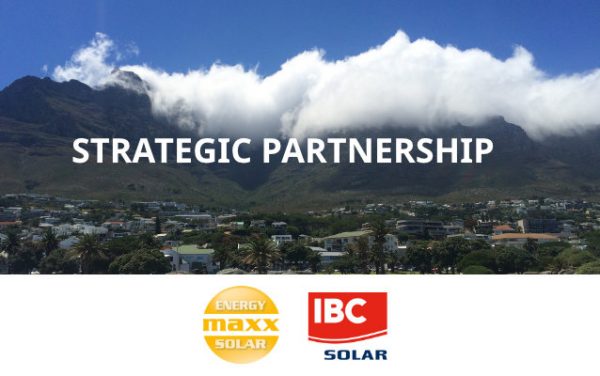
Breaking News:
We are proud to announce to our customers and partners that we are entering into a close and strategic partnership (joining forces) with one of the world's leading energy systems houses - the German PV pioneer IBC-SOLAR - from 2017 onwards. Your contacts remain intact - but the possibilities are unlimited with this future partnership!
Home Owners:
Greater safety and quality of life thanks to maximum energy independence.
With our new energy solutions from IBC-SOLAR you will be turning your own energy provider. Power failures, rising energy costs and poor service are now a thing of the past.
• More quality through premium products "made in germany"
• More safety through guarantee services and all-round care offers including maintenance
• More independence through innovative storage and smart consumption management
• And much more ...
For Entrepreneurs:
More planning security and cost advantages through self-supply.
Ensure decisive competitive and cost advantages and make your company with IBC SOLAR solutions more independent from the power grid.
• More profitability, among others. By an amortization period of less than 7 years
• More quality through premium products "made in germany"
• Increased security through warranty services and maintenance services
• And much more ...
For our Partners and PV Installers:
More business and growth opportunities with holistic energy solutions and services.
Use IBC-SOLAR's innovative premium solutions to create a completely new customer base. This extensive partner service helps you focus on your own growth.
• Increased sales through strong support for new customer acquisition and faster processing
• Increased security through premium quality, simple processes, and a single point of contact
• More perspectives by opening up new business areas and innovative energy solutions
• And much more ...
About IBC SOLAR:
IBC-SOLAR - the leading system provider for PV and energy solutions.
Since being formed in 1982, IBC-SOLAR has developed into the leading system provider for PV and energy solutions – with over 3 gigawatts installed capacity, seven international subsidiaries and projects throughout the world.
• Over 30 years company history since 1982
• Solar power supply for 1.8 million people
• More than 1.000 Premium Partners worldwide
• And Much more ...
19.01.2017 |
